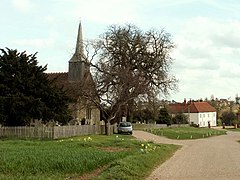Black Notley is a village and civil parish in Essex, England. It is located approximately 1+1⁄2 miles (2.4 km) south of Braintree and is 9 miles (14 km) north-northeast from the county town of Chelmsford. According to the 2011 census including Young's End it had a population of 2,478.[1]
| Black Notley | |
|---|---|
 Black Notley church and Hall | |
Location within Essex | |
| Population | 1,646 (2001) 2,478 (2011)[1] |
| OS grid reference | TL764210 |
| Civil parish |
|
| District | |
| Shire county | |
| Region | |
| Country | England |
| Sovereign state | United Kingdom |
| Post town | BRAINTREE |
| Postcode district | CM77 |
| Dialling code | 01376 |
| Police | Essex |
| Fire | Essex |
| Ambulance | East of England |
| UK Parliament | |
History
editThe place-name 'Notley' is first attested in a Saxon charter of 998 as Hnutlea, and appears as 'Nutlea' in the Domesday Book of 1086. The name means 'nut wood'. 'Black Notley' is first attested in 1240.[3]
The parish church is dedicated to both St. Peter and St. Paul, and has walls of flint and pebble. The nave was constructed in the 12th century and the chancel was rebuilt around the 16th century when also the south porch and bell-turret were added. Around 100 yards to the south of the church is the 15th century Grade II listed Black Notley Hall.[4]
Geography
editThe village is in the district of Braintree, but as of 2010, forms part of the parliamentary constituency of Witham. It has its own parish council, and is part of the wider Cressing, Black Notley, White Notley and Faulkbourne parish cluster.[5]
The Cressing railway station, on the Braintree Branch Line, is around half a mile from the village centre. It is close to the River Brain. In 2002 work was completed on the new estate, built in place of the old hospital giving 350 new houses to the area.[6]
Notable residents
edit- William Bedell (1571–1642), Anglican churchman, Bishop of Kilmore and Provost of Trinity College Dublin.[7]
- Richard Symonds (1617–1660), royalist and antiquary, he wrote about the First English Civil War.[8]
- John Ray (1627–1705), naturalist, known as the father of English natural history.[9]
- Arthur Halestrap (1898–2004), one of the last surviving soldiers of WWI, lived locally
References
edit- ^ a b "ONS Data Explorer". ONS. Retrieved 5 February 2015.
- ^ "Black Notley Parish Council Website". Black Notley Parish Council. Retrieved 26 September 2021.
- ^ Eilert Ekwall, Concise Oxford Dictionary of English Place-names, p.345.
- ^ 'Black Notley', in An Inventory of the Historical Monuments in Essex, Volume 2, Central and South west (London, 1921), pp. 18-21. British History Online
- ^ "Parish cluster map". www.braintree.gov.uk. Archived from the original (JPG) on 14 October 2006. Retrieved 27 January 2007.
- ^ "BLACK NOTLEY Where old and new are united". Essex Chronicle. Archived from the original on 6 February 2015. Retrieved 5 February 2015.
- ^ . Encyclopædia Britannica. Vol. 3 (11th ed.). 1911. p. 616.
- ^ Thomas, Daniel Lleufer (1898). . Dictionary of National Biography. Vol. 55. pp. 276–277.
- ^ Thompson, D'Arcy Wentworth (1911). . Encyclopædia Britannica. Vol. 22 (11th ed.). pp. 931–932.
External links
edit
